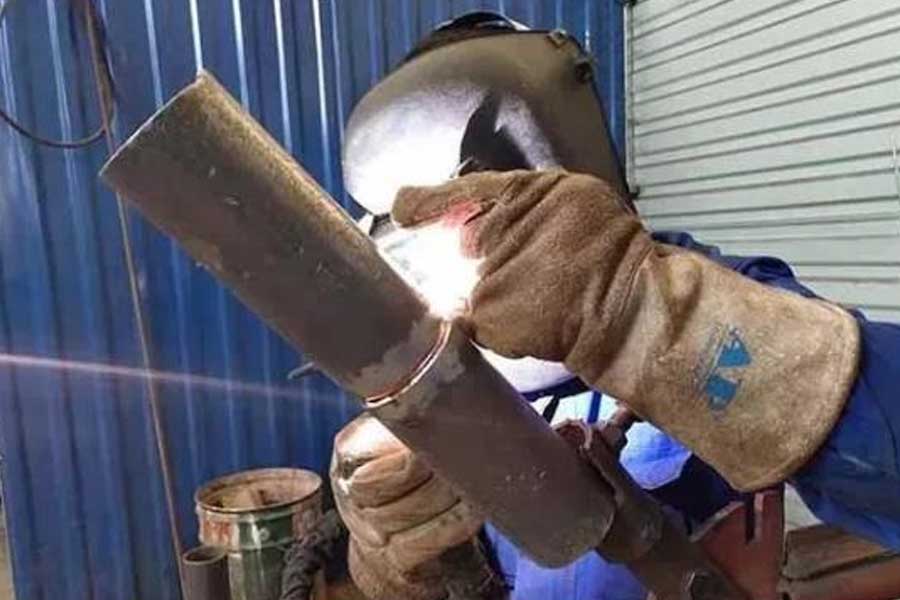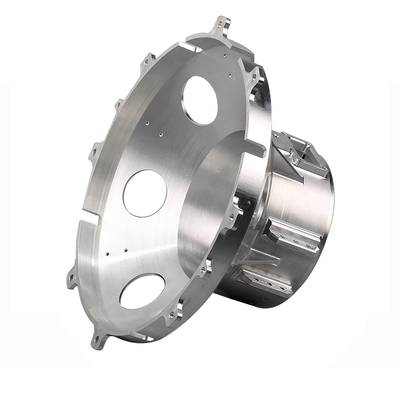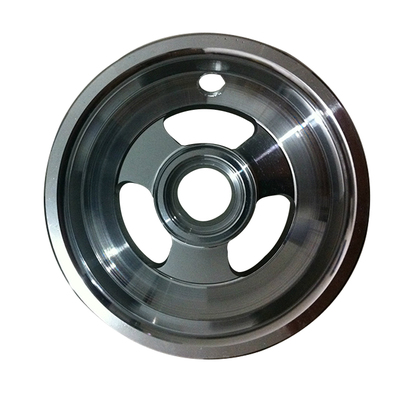What factors affect the appearance of argon arc welding porosity?
Aiming at the common vent problems in manual argon arc welding, based on the author's years of work experience in manual argon arc welding, the reasons for the pores in argon arc welding are analyzed, and some solutions and attention are introduced. matter. Help welders to deal with such problems encountered in actual production, and better master the manual tungsten argon arc welding technology.
Argon arc welding is a welding technique that uses argon as a shielding gas. Also known as argon gas shielded welding. It is to pass argon shielding gas around the arc welding to isolate the air from the welding area and prevent the oxidation of the welding area.
The argon arc welding technology is based on the principle of ordinary arc welding. It uses argon gas to protect the metal welding material. Through high current, the welding material is melted into a liquid on the welded substrate to form a molten pool. A welding technology in which the welding material achieves metallurgical bonding. Because the argon gas is continuously supplied during high-temperature fusion welding, the welding material cannot be in contact with oxygen in the air, thereby preventing the oxidation of the welding material, so it can weld stainless steel and iron hardware. .
The reason why argon arc welding can obtain such a wide range of applications is mainly because of the following advantages.
1. Argon protection can isolate the adverse effects of oxygen, nitrogen, hydrogen, etc. in the air on the arc and molten pool, reduce the burning of alloy elements, and obtain dense, spatter-free, and high-quality welded joints;
2. The arc combustion of argon arc welding is stable, the heat is concentrated, the arc column temperature is high, the welding production efficiency is high, the heat-affected zone is narrow, and the welded parts are welded with low stress, deformation and crack tendency;
3. Argon arc welding is open arc welding, which is convenient for operation and observation;
4. The electrode loss is small, the arc length is easy to maintain, and there is no flux or coating layer during welding, so it is easy to realize mechanization and automation;
5. Argon arc welding can weld almost all metals, especially some refractory metals and easily oxidized metals, such as magnesium, titanium, molybdenum, zirconium, aluminum, etc. and their alloys;
6. All-position welding can be carried out without being restricted by the position of the weldment.
However, due to the weak wind resistance of argon arc welding, it is particularly sensitive to rust, water, and oil stains. It has strict requirements on gas purity, bevel cleaning, and welding technology, and it is easy to produce pores. This article combines the actual production to analyze the porosity problem of argon arc welding, and puts forward some treatment methods and precautions.

Influencing factors of stomata
1. Argon is impure
The purity of argon is not less than 99.7% when welding carbon steel, and not less than 99.9% when welding aluminum, and the purity of hydrogen used for welding titanium and titanium alloy is as high as 99.99%.
Method for detecting argon purity:
(1) Weld the polished steel plate or pipe without adding welding wire, and then remelt it several times on the weld bead. If there are pores, it means that the argon gas is impure.
(2) When welding, there are very small sparks around the arc, which also indicates that the argon gas is impure.
(3) Sometimes when the purity of argon gas is close to the purity required for welding, the above two detection methods cannot be used to detect it, but when welding a gap with a weld, intermittent pores will be generated at the root of the weld. , Or surface pores are generated during the cover welding, or there is a layer of oxide scale on the surface of the weld bead.
(4) Spot welding a few points on the nickel plate, the solder joints are silver-white, and the surface is mirror-like, indicating that the purity of the argon gas is qualified.
2. Argon flow
If the flow rate of argon is too small, the ability to resist wind interference is weak; if the flow rate of the gas is too large, the near-wall laminar flow formed when passing through the nozzle is very thin. The protection effect becomes worse. Therefore, the flow rate of argon must be appropriate to stabilize the flow.
3. Air belt leakage
Air belt interface or air belt leakage will cause the gas flow to be too small during welding, and the air will be sucked into the air belt, resulting in poor protection.
4. The influence of wind
Slightly higher winds will cause turbulence in the argon protective layer, which will result in poor protection. Therefore, wind-proof measures should be taken when the wind speed is> 2m/s; when welding the pipe, the pipe mouth should be blocked to avoid the formation of draught in the pipe.
5. The influence of the torch nozzle
If the nozzle diameter is too small, when the effective protection range of the argon gas around the arc is smaller than the area of the molten pool, it will cause poor protection and generate pores. Especially for field operations and welding large pipes, a larger diameter nozzle should be used to effectively protect the arc and molten pool.
6. The distance between the welding gun nozzle and the workpiece
If the distance is small, the sensitivity to crosswinds is small; if the distance is large, the ability to resist wind interference is weak.
7. The pressure in the cylinder is too small
Stop when the pressure in the cylinder is less than 1MPa.
8. The welding torch angle is too large
If the angle of the welding torch is too large, on the one hand, air will be carried into the molten pool, and on the other hand, the protection effect of the argon gas flow on the long arc side on the arc and the molten pool will be worse.
9. Influence of hydrogen flow meter
The flow meter is unstable, and the protection effect will be affected by fluctuations.
10. Impact of operation
When using a hydrogen arc welding torch with a control button, the gas must be vented before welding to avoid excessive pressure in the gas belt, which may cause excessive gas flow during arc ignition, resulting in blowholes.
11. The welding torch accessories are not suitable
The tungsten clamps are not matched, the gas path is blocked and the gas flow is not smooth, and the protective gas flows out from one side of the nozzle, and a complete protective ring cannot be formed.
Influence of welding materials
1. Influence of welding wire type
Do not use submerged arc welding wire to replace manual tungsten hydrogen arc welding wire, otherwise intermittent or continuous pores will occur.
2. The welding wire is not clean
Rust, oil and water on the surface of the welding wire will directly cause a large number of pores in the weld.
Influence of base material material
1. The influence of plate or pipe quality
If there is an interlayer in the plate or pipe, the impurities in the interlayer will promote the generation of pore defects.
2. The influence of steel grade
Boiling steel (with high oxygen content and many impurities) cannot be welded by argon arc welding.
The influence of tungsten
1. The influence of tungsten tip
The tungsten tip is not sharp and the arc drift is unstable, destroying the argon protection zone, and oxidizing the molten pool metal to produce pores.
2. When the arc is started, the arc climbs up and the protection is not good
When using high-frequency arc ignition equipment, the temperature of the tungsten terminal is low when the arc is started, and it does not have enough thermal emission electron capability. The electrons are easily emitted from the place with oxide film, and climb along the electrode to find the place with oxide. At this time, the arc is elongated, and the protection effect of argon on the molten pool becomes worse. When the temperature of the tungsten electrode rises, electrons are emitted from the front end of the tungsten electrode, and the arc length is correspondingly shortened. At this time, the oxide on the surface of the tungsten electrode can be eliminated by polishing it.
Influence of welding process
1. Groove cleaning
The groove surface and the 10mm range on both sides of the groove should be polished clean to avoid the magnetism generated by the arc during welding from sucking the rust near the molten pool into the molten pool.
2. The influence of welding speed
The welding speed is too fast. Due to the influence of air resistance on the shielding airflow, the argon airflow will bend and deviate from the center of the electrode and the molten pool, which is not good for the molten pool and arc protection.
3. The influence of the arc extinguishing method
When extinguishing the arc, use the method of attenuating current or adding welding wire, bringing the arc to the side of the groove and lowering the arc. Do not stop the arc suddenly and cause the high temperature molten pool to separate from the effective protection of the argon gas flow, and avoid pores or shrinkage holes in the arc crater.
4. The influence of welding current
The welding current is too small, the arc is unstable, and the arc drifts irregularly at the end of the tungsten electrode, destroying the protection zone. If the welding current is too large, the arc will disturb the airflow and the protection effect will be worse.
5. The influence of tungsten electrode extension
The tungsten electrode extends too long, and the protective effect of hydrogen on the arc and molten pool becomes poor.
Although there are many factors that cause pores in manual argon arc welding, as long as you understand the characteristics of argon arc welding, and check the influencing factors one by one according to the actual situation, eliminate all the factors that cause pores in the weld during argon arc welding. , It can improve the welding quality in actual production.
Link to this article: What factors affect the appearance of argon arc welding porosity?
Reprint Statement: If there are no special instructions, all articles on this site are original. Please indicate the source for reprinting:https://www.cncmachiningptj.com/,thanks!
 PTJ® provides a full range of Custom Precision cnc machining china services.ISO 9001:2015 &AS-9100 certified. 3, 4 and 5-axis rapid precision CNC machining services including milling, sheet metal to customer specifications,Capable of metal & plastic machined parts with +/-0.005 mm tolerance.Secondary services include CNC and conventional grinding, laser cutting,drilling,die casting,sheet metal and stamping.Providing prototypes, full production runs, technical support and full inspection.Serves the automotive, aerospace, mold&fixture,led lighting,medical,bicycle, and consumer electronics industries. On-time delivery.Tell us a little about your project’s budget and expected delivery time. We will strategize with you to provide the most cost-effective services to help you reach your target,Welcome to Contact us ( sales@pintejin.com ) directly for your new project.
PTJ® provides a full range of Custom Precision cnc machining china services.ISO 9001:2015 &AS-9100 certified. 3, 4 and 5-axis rapid precision CNC machining services including milling, sheet metal to customer specifications,Capable of metal & plastic machined parts with +/-0.005 mm tolerance.Secondary services include CNC and conventional grinding, laser cutting,drilling,die casting,sheet metal and stamping.Providing prototypes, full production runs, technical support and full inspection.Serves the automotive, aerospace, mold&fixture,led lighting,medical,bicycle, and consumer electronics industries. On-time delivery.Tell us a little about your project’s budget and expected delivery time. We will strategize with you to provide the most cost-effective services to help you reach your target,Welcome to Contact us ( sales@pintejin.com ) directly for your new project.

- 5 Axis Machining
- Cnc Milling
- Cnc Turning
- Machining Industries
- Machining Process
- Surface Treatment
- Metal Machining
- Plastic Machining
- Powder Metallurgy Mold
- Die Casting
- Parts Gallery
- Auto Metal Parts
- Machinery Parts
- LED Heatsink
- Building Parts
- Mobile Parts
- Medical Parts
- Electronic Parts
- Tailored Machining
- Bicycle Parts
- Aluminum Machining
- Titanium Machining
- Stainless Steel Machining
- Copper Machining
- Brass Machining
- Super Alloy Machining
- Peek Machining
- UHMW Machining
- Unilate Machining
- PA6 Machining
- PPS Machining
- Teflon Machining
- Inconel Machining
- Tool Steel Machining
- More Material





